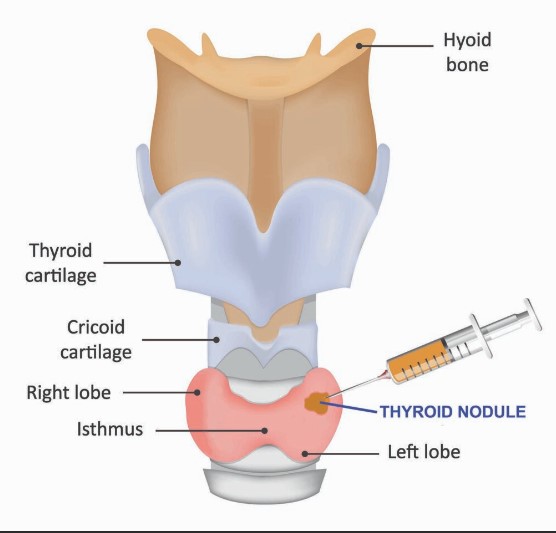What is a thyroid biopsy?
A thyroid biopsy is a procedure in which a small sample of cells and fluid is removed from the thyroid gland. Your physician will use it to help diagnose certain thyroid conditions.
When is a thyroid biopsy done?
You don’t need a biopsy to diagnose all thyroid conditions. In many cases, a blood test and imaging results are enough. However, your healthcare provider might recommend a thyroid biopsy if you have thyroid nodules. Thyroid nodules are small solid or fluid-filled bumps that can form in your thyroid gland. Most nodules are benign (noncancerous), but some (around 5% to 15%) can be malignant (cancerous).
A thyroid biopsy can help your provider find out what caused a nodule. Healthcare providers are likelier to biopsy nodules larger than 1 centimeter (0.39 inches).
How is a thyroid biopsy done?
Healthcare providers do thyroid biopsy procedures in one of three ways:
Fine-needle aspiration (FNA). Nearly all thyroid nodule biopsies use the FNA method. During this minimally invasive procedure, a provider uses a long, thin needle (22-gauge diameter or smaller) to draw cells and fluid from one or more thyroid nodules. They use ultrasound imaging to guide the needle directly into the nodule.
Core-needle biopsy (CNB). This procedure is like FNA, but the needle has a larger diameter (14- to 20-gauge). A provider might opt for this method if they need larger, more intact tissue samples.
Surgical thyroid biopsy. Rarely, a healthcare provider may need to do a surgical biopsy. This involves making a small incision in your neck to access your thyroid gland. Imagecare does not provide Surgical Biopsies
How to prepare for a thyroid nodule biopsy
Preparation depends on the type of thyroid biopsy:
Thyroid needle biopsy (FNA or CNB)
Unless your provider tells you otherwise, you should be able to eat and drink normally before your appointment. But it’s a good idea to ask whether you should stop taking any medications in the days leading up to your procedure.
Surgical thyroid biopsy
If you have a surgical thyroid biopsy, your provider will give you preparation instructions.
Your healthcare provider is the best person to tell you how to prepare for your thyroid biopsy. Be sure to ask them if you have any questions.
What to expect
Providers usually use FNA or CNB to perform a thyroid biopsy. However, in rare instances, they may need a surgical biopsy. The steps to each are listed below.
Thyroid needle biopsy (FNA or CNB)
These are typically outpatient procedures, meaning you’ll go home the same day. Your provider will:
Give you local anesthesia to numb your neck.
Place a handheld device called an ultrasound transducer on your neck. This allows them to see your thyroid and locate the nodules.
Gently insert a thin needle through your skin and into the thyroid nodule.
Carefully draw out a fluid and tissue sample. You’ll need to remain very still during this part.
Remove the needle and place a bandage over the injection site.
Send your sample to a cytologist for testing.
If you have more than one nodule, your provider might repeat this process. The procedure takes about 10 to 20 minutes to complete.
Surgical thyroid biopsy
This approach is very rare. However, a provider may need to perform a surgical biopsy if the results from your FNA or CNB are unclear or if they need additional information.
The procedure involves removing nodules and/or tissue samples directly from your thyroid gland and sending them to a lab for testing.
What are the side effects of a thyroid biopsy?
Typical thyroid biopsy side effects include soreness and bruising at the injection site. You can manage any discomfort with over-the-counter (OTC) pain relievers like acetaminophen (Tylenol®) or ibuprofen (Motrin®).
Complications are rare. But they can include:
Bleeding.
Infection.
Cyst formation.
Results and Follow-Up
What do my thyroid biopsy results mean?
According to the American Thyroid Association, six possible biopsy results exist. The following chart explains what each one means.
- Thyroid biopsy results: What the results mean
- Benign The nodule is noncancerous. About 70% of all thyroid biopsy results come back as benign.
- Malignant: The nodule is cancerous. About 3% to 7% of all thyroid biopsy results return as malignant.
- Suspicious There’s a 60% to 75% chance that the nodule is cancerous.
- Atypia of undetermined significance (AUS): The nodule has benign and malignant characteristics. About 5% to 15% of these nodules are cancerous.
- Follicular neoplasm: It’s hard to tell if the nodule is benign or cancerous unless surgically removed. About 15% to 30% of these nodules are cancerous.
- Nondiagnostic This result means there aren’t enough cells in the sample to make a reliable diagnosis.
When should I know the results?
Most people receive their biopsy results within one week.
If the results are abnormal, what are my next steps?
Your healthcare provider will let you know your results and whether you need treatment.
Each case is unique, but here’s a general idea of what to expect:
Benign nodules often require “watchful waiting” and a follow-up ultrasound in 12 months.
Malignant nodules almost always need surgical removal.
Suspicious nodules may require surgical removal, depending on molecular profiling.
When should I call my doctor?
After your thyroid biopsy, let your healthcare provider know if you develop signs of infection like:
Fever.
Chills.
Redness, swelling or pus coming from the injection or incision site.
For more information, please call our interventional Radiology department at : 973-810-8100

